A study on the translation of adverbs in harry potter and the philosophers stone from english into vietnamese
Bạn đang xem bản rút gọn của tài liệu. Xem và tải ngay bản đầy đủ của tài liệu tại đây (917.35 KB, 81 trang )
i
MINISTRY OF EDUCATION AND TRAINING
HANOI OPEN UNIVERSITY
TRAN THUY HANG
A STUDY ON THE TRANSLATION
OF ADVERBS IN “HARRY POTTER AND THE
PHILOSOPHER’S STONE”
FROM ENGLISH INTO VIETNAMESE
(NGHIÊN CỨU VỀ VIỆC CHUYỂN ĐỔI CÁC TRẠNG TỪ TRONG TÁC
PHẨM “HARRY POTTER VÀ HÒN ĐÁ PHÙ THỦY” VỀ TƢƠNG
ĐƢƠNG TRONG TIẾNG VIỆT)
M.A. THESIS
Field: English Language
Code: 60220201
Supervisor: Prof. Dr. Hoang Van Van
HANOI - 2013
ii
DECLARATION
I hereby declare that no part of the enclosed Master Thesis has been
copied or reproduced by me from any other‟s work without
acknowledgement and that the thesis is originally written by me under
strict guidance of my supervisor.
Hanoi, 20 - 11 - 2013
Supervisor
Prof. Dr. Hoàng Văn Vân
Candidate
Trần Thúy Hằng
iii
ACKNOWLEDGEMENTS
I would like to thank all those who have given me their generous helps,
commitment and enthusiasm, which have been the major driving force to
complete the current paper.
I am particularly grateful to my supervisor, Prof. Dr. Hoàng Văn Vân, who
generously spent his precious time on insightful guidance and earnest help all
through the searching, analysis and paper-writing stages, and kindly sent his
valuable and detailed comments on it.
My sincere thanks also go to Dean and all the lecturers at Faculty of Graduate
Studies for their constructive ideas and assistance.
I surely would express my sincere thanks to all friends and workmates who
have offered their helping hands whenever I am in need of help. I‟m so
grateful to their understanding of my improper appeal for their aid and their
kindness towards the inconveniency I have often put to them.
To my fiancé, thank you for always having faith in me, for tolerating my
temper and being extremely supportive in every way possible. To my dear
friends, Hạnh and Ng. Hạnh, you have been a rich source of encouragement
and love for me, I am truly grateful to have all of you in my life.
Finally, I am deeply indebted my parents for their great encouragement and
support during my study at Hanoi Open University. Thank you for the great
love and pray in my life.
Trần Thúy Hằng
iv
TABLE OF CONTENTS
DECLARATION i
ACKNOWLEDGEMENTS iii
TABLE OF CONTENTS iv
LIST OF ABBREVIATIONS vii
LIST OF TABLES viii
PART I: INTRODUCTION TO THE STUDY 1
1. Rationale of the study 1
2. Aims of the study 3
3. Research questions 3
4. Scope of the study 3
5. Methods of the study 3
6. Design of the study 4
PART II: DEVELOPMENT 6
CHAPTER 1: LITERATURE REVIEW AND THEORETICAL BACKGROUND 6
1. 1. A review of previous studies 6
1. 2. Theoretical Background 7
1.2.1. Theory of Word 7
1.2.2.1. Word in English 7
1.2.2. Adverbs in English 11
1.2.2.1. Grammatical Definitions of Adverbs 11
1.2.2.2. Form of Adverbs 12
1.2.2.3. Functions of Adverbs 13
1.2.2.4. Position of Adverbs 14
1.2.3 Adverbs in Vietnamese 14
1.2.3.1 Function of Vietnamese Adverbs 16
1.2.3.2 Position of Vietnamese Adverbs 18
1.2.4. Theory of Translation 21
1.2.4.1. Definitions of Translation 21
v
1.2.4.2. Language and Culture 22
1.2.4.3. Translation Equivalence 24
1.2.4.4. Translation procedures 26
1.2.4.5. Translation Methods 33
1.2.4.6. Communicative Translation and Semantic Translation 36
CHAPTER 2: METHODS AND PROCEDURE 39
2.1. Aims of the Research 39
2.2. Research Design 39
2.3. Method of Research 40
2.3.1. Data Source 40
2.3.2. Method and Technique of Collecting and Analyzing Data 41
2.4. Research Procedures 42
CHAPTER 3: FINDINGS AND DISCUSSION 44
3.1. The Strategies used in English-Vietnamese Translation of Adverbs of
Manner in “Harry Potter and the Philosopher's Stone” 45
3.1.1. Adverbs of manner translated as adjective + verb into the TL 45
3.1.2. Adverbs of manner translated as verb into the TL 46
3.1.3. Adverbs of manner translated as phrases into the TL 47
3.1.4. Adverbs of manner are not translated (zero translation) into the TL 48
3.2. The Strategies used in English-Vietnamese Translation of Adverbs of
Frequency in “Harry Potter and the Philosopher's Stone” 50
3.2.1. Adverbs of frequency translated as adverbs of frequency into the TL 50
3.2.2. Adverbs of frequency are not translated (zero translation) into the TL 51
3.3. The Strategies used in English-Vietnamese Translation of Adverbs of Place
in “Harry Potter and the Philosopher's Stone” 53
3.3.1. Adverbs of place translated as phrases into the TL 53
3.3.2. Adverbs of place translated as adverbs of place into the TL 54
3.4. The Strategies used in English-Vietnamese Translation of Adverbs of Time in
“Harry Potter and the Philosopher's Stone” 55
3.4.1. Adverbs of time translated as Noun into the TL 56
3.4.2. Adverbs of time translated as adverbs of time into the TL 57
vi
3.4.3. Adverbs of time are not translated (zero translation) into the TL 58
3.5.1. Adverbs of degree translated as adverbs of degree into the TL 60
3.5.2. Adverbs of degree translated as phrases into the TL 60
3.5.3. Adverbs of degree are not translated (zero translation) into the TL 61
PART III CONCLUSION 64
1. Recapitulation 64
2. Limitations of the study 67
3. Suggestions for a further study 67
REFERENCES 69
vii
LIST OF ABBREVIATIONS
Adj
Adjective
Adv
Adverb
N
Noun
SL
Source language
TL
Target language
V
Verb
viii
LIST OF TABLES
Table 3.1: The tokens and percentage of strategies used in translating
adverb of manner
Table 3.2: The tokens and percentage of strategies used in translating
adverb of frequency
Table 3.3: The tokens and percentage of strategies used in translating
adverb of place
Table 3.4: The tokens and percentage of strategies used in translating
adverb of time
Table 3.5: The tokens and percentage of strategies used in translating
adverb of degree
1
PART I: INTRODUCTION TO THE STUDY
1. Rationale of the study
Words are ubiquitous. In a literate society words are everywhere and
unavoidable. Every day people read, write, speak, and hear words. Words can
be readily found in books and magazines. They can also be found plastered
on signs, engraved on buildings, scrawled on food, printed on clothing, and
they often even reside on the tips of our tongues. Obviously, ideas, notions
and feelings are actually universal but the way we describe them in different
languages is very unique. Therefore, translation plays a crucial role in
enhancing better understanding each other, transmitting information,
exchanging experiences and getting knowledge. However, translating from
one language into another is no easy task. Translation must take into account
a number of constraints, including the context, the rules of grammar of the
two languages, their writing conventions, and their idioms. In translating,
there are some rules that must be obeyed by translator. At least the translator
must master the source language (SL) because every language has its own
system. Every language has its own grammatical or structural system in
conveying an idea. The translator must be able to transform the structure of SL
to the appropriate structure of the target language (TL). It means that, the
reader and listener can understand about the translation result. Part of speech is
very important to make sentences. Maclin (1996) states “Parts of Speech in
English are traditionally classified into eight parts; they are verb, adjective,
noun, pronoun, adverb, preposition, conjunction, and interjection”. Adverb is a
part of speech which serves as a modifier of verbs, adjectives, clauses,
sentences and other adverbs, except for nouns; modifiers of nouns are
2
primarily determiners and adjectives. I found out that many Vietnamese
students are experiencing a lot of difficulties when trying to translate English
adverbs. They sometimes wrote down funny sentences which are not pure
Vietnamese simply because they translated improperly phrases/sentences
containing adverbs into their mother tongue. Being a translator, I would like
to discover the art of translation through some translated work in order to find
ways to transfer English adverbs to Vietnamese. Furthermore, I also like to
know whether my knowledge of English adverbs can be used to help some
translator-wannabe deal with the problems.
Rowling (born 31 July 1965) is considered one of the greatest authors
nowadays and her novel has been translated in hundreds of different
languages and has become one of the bestselling novels through years. More
specifically, the adverbs in this book are a challenge for the translator. This
novel was chosen to be the object of the present study also because it was
published rather recently, in 1997, and thus is can be regarded as a very good
example of popular literature of the end of the 20
th
century. Furthermore, the
novel has provoked many controversial thoughts and lively discussion among
its readers and in the media because of its rather delicate issues and themes
Besides, the novel contains many data that are relevant with the problem
discussed and analyzed in this paper.
Because of reasons mentioned above, my thesis is entitled “A Study on The
Translation of Adverbs in “Harry Potter and the Philosopher’s Stone” from
English into Vietnamese”. I hope this thesis will help students and all
concerned understand and translate English adverbs more easily.
3
2. Aims of the study
The aim of the research is to shed light on
To find out the types of adverbs occurring in the English novel
To describe how adverbs in the SL novel are translated into the TL
novel.
To find out the procedure and strategy used in the process of
translation.
3. Research questions
Consequently, three questions will be investigated:
1. How are adverbs in “Harry Potter and the Philosopher‟s stone”
translated from English into Vietnamese?
2. What procedures and strategies are used in the process of
translation?
4. Scope of the study
This study investigates the ways used in translating adverbs from English
into Vietnamese. Given the limited time, resources, conditions, and the
length of the thesis, the researcher focuses only on Rowling‟s novel
“Harry Potter and the Philosopher's Stone” translated by Lý Lan. This
novel consists 17 chapters and has 249 pages.
5. Methods of the study
The method that was used in the analysis of the adverbs in this study is
descriptive and more qualitative than quantitative. However, a few
4
percentages have been used to clarify the division between different
strategies used in translating adverbs. The material of the present study
was collected by collecting 25 adverbs of time, manner, place, degree and
frequency in the original version of “ Harry Potter and the
Philosopher‟s stone”.
6. Design of the study
This thesis includes three parts:
Part 1, Introduction, presents the statements of the problem,
the justification for the study, the scope of the study, the organization, as
well as definitions of terms.
Part 2, Development, consists of three chapters:
Chapter One provides an overview of the previous studies on
translation and adverbs. This chapter also introduces some theoretical
preliminaries on the translation theory, the definitions and classification
of adverbs in English and Vietnamese.
Chapter Two includes an overview of the data as well as the
methodology that were used in analyzing the translation of adverbs in
“Harry Potter and the Philosopher's Stone” by J.K. Rowling, and how
they are collected and investigated.
Chapter Three reports the results of the study and presents
some discussion of the major findings. The results will be presented based
on the research questions that guide the current study.
5
Part 3: Conclusion consists of the conclusion of the whole
study, the implications for the translation and for the teaching and
learning. Limitations in doing the research and suggestions for further
studies are also mentioned in this chapter.
6
PART II: DEVELOPMENT
CHAPTER 1: LITERATURE REVIEW AND THEORETICAL
BACKGROUND
1. 1. A review of previous studies
Translation is a complex process where fragile balance is achieved
between the equivalence of the text translated and the linguistic means
chosen. In reality, translation from English into Vietnamese is a complex
work which poses great difficulties to the translator but there are a few
researchers dealing with adverb translation. There are researchers who have
done analysis about language translation and the process of translation from
English into Vietnamese. So, in conducting this analysis, I have consulted the
previous paper and research findings. They are: Sinaiko and Brislin, Richard
(1970) in “Experiments in Language Translation: Technical English-to-
Vietnamese” documents the results of a series of experiments on translating
technical material from English to Vietnamese. The paper addresses the
questions of translation speed, number of errors, and quality assessment.
Three different methods for measuring the quality of translations are
examined; back-translation, knowledge testing, and performance testing.
In Vietnamese, Nguyễn Thƣợng Hùng in Dịch thuật: từ Lý Thuyết đến Thực
Hành (2005) not only focuses on the theory and the methods of translation
from English into Vietnamese but also describes the set of processes that
actually employed in translating.
7
About adverb and adverbial in English and Vietnamese, Võ Huỳnh Mai
(1973) Bàn thêm về phạm vi của trạng ngữ trong tiếng Việt focuses on the
study on function of adverb in Vietnamese.
Nguyễn Hồng Cổn (2001) Về vấn đề tương đương trong dịch thuật focuces
on how to translate single words in English into Vietnamese effectively.
Nguyễn Ngọc Toàn (MA Thesis, 2010) Khảo sát thuật ngữ kinh tế trong
Văn kiện Đại hội Đảng Cộng sản Việt Nam và sự chuyển dịch tương ứng
sang tiếng Anh (từ văn kiện Đại Hội IX - X ) investigates economic terms
used in the ninth and tenth National Congress of the Communist Party of
Vietnam and their equivalence in English.
Hà Thành Chung (MA thesis, 2007) Cú phân từ định ngữ, trạng ngữ tiếng
Anh và các kết cấu tương đương trong tiếng Việt is a contrastive study of
commonly-used adverb and adverbial in English and Vietnamese.
In brief, many researches dealing with translation from English into
Vietnamese in different aspects but no one focus on the translation of
adverbs and adverbial. On doing this research, the writer has followed the
viewpoint of linguistics in doing an investigation into common ways for
translating adverbs from English into Vietnamese and found out the main
approaches taken by translators in translating adverbs from English into
Vietnamese.
1. 2. Theoretical Background
1.2.1. Theory of Word
1.2.2.1. Word in English
a. Word Meaning
As we all know, communication becomes more and more a crucial
8
factor in social organization and meaning plays such an important role in
communication. Meaningless utterances have no value in communication;
they can only make their language users a laughing stock, which is why
understanding the meaning is very important for the language users. The
meaning of a word is not merely the result you get from your search in a
good dictionary because it depends on many factors concerned.
In Meaning in English, Jeffries (1998) states that “meaning is a kind of
invisible unclothed being waiting for the clothes of language to allow it to be
seen, which is why it is very necessary to take off the clothes of language to
understand the real meaning of words, phrases, and sentences”. For
example, the red flag at the seaside of a resort means danger.
In the book Semantics, Leech (1977) shows seven types of meaning:
i. Conceptual meaning (sometimes called “denotative” or “cognitive”
meaning
Denotative meaning refers to the literal meaning of a word. For example,
the meaning of the word woman can be specified as +human, -male, +adult.
Three properties human, adult, and female provide a criterion of the correct
use of the word woman.
ii. Connotative meaning
Connotative meaning is the communicative value an expression has by virtue
of what it refers to, over and above its purely conceptual meaning.
In other words, according to him, it refers to the associations that are
connected to a certain word or the emotional suggestions related to that word.
The connotative meanings of a word exist together with the denotative
meanings. The connotations for the word woman can include not only its
denotative meaning but concomitants of womanhood (capable of speech,
experienced in cookery, skirt-or-dress wearing) as well as some traditional
9
attitudes such as frail, prone to tears, emotional or other qualities such as
beautiful, gentle, compassionate, sensitive, and hard-working.
iii. Stylistic meaning
Stylistic meaning is that which a piece of language conveys about the social
circumstances of its use. In this style of meaning, a word can be recognized
by the typical dimensions: Individuality (the language of Mr X, of Mrs Y,
and so on); Dialect (the language of a geographical region or of a social
class); Time (the language of the eighteen century, etc); Style (the language
of poetry, the language of journalism, and so forth); Singularity (the style of
Dickens, of Hemingway, etc ).
iv. Affective meaning
According to Leech (1977) affective meaning is often explicitly conveyed
through the denotative or connotative content of the words used. He also
claims that affective meaning is largely a parasitic category in the sense that
to express our emotions we rely upon the mediation of other categories of
meaning – denotative, connotative, or stylistic.
v. Reflected meaning
Reflected meaning is the meaning which arises in case of multiple
conceptual meaning, when one sense of a word forms part of our response to
another sense.
vi. Collocative meaning
Collocative meaning consists of the associations a word acquires on account
of the meanings of words which tend to occur in its environment. For
example: pretty and handsome share common ground in the meaning of
good-looking, but may be distinguished by the range of nouns with which
they are likely to co-occur or collocate: pretty girl, boy, flower, garden, etc.
and handsome boy, man, car, vessel, etc.
10
vii. Thematic meaning
Thematic meaning is what communicated by the way in which the
message is organized in terms of order and emphasis.
Moreover, mentioning word meaning, in Semantics and Translation,
Barnwell (1990) analyses meaning with five different kinds of associative
meaning, in which includes: connotative meaning, stylistic (social) meaning,
affective meaning, reflected meaning, collocative meaning.
b. Sense Relations
In order to understand words comprehensively, we must rely upon the uses of
themselves through various types of meaning as well as in the relations of
senses.
- Polysemy: Hurford (1997) defines “A case of polysemy is one where
a word has several very closely related senses.”
Ex: Mouth (of a river vs. of an animal) is a case of polysemy. The two senses
are clearly related by the concepts of an opening from the interior of some
solid mass to the outside, and of a place of issue at the end of some long
narrow channel.
- Synonymy: Lyons (1995) defines two expressions as full
synonymous if the following conditions are met:
All their meanings are identical
They are synonyms in all contexts
They are semantic equivalent in all aspects of their
meaning
- Homonymy: According to Hurford (1988), a case of homonymy is
one of an ambiguous word whose different senses are far apart from each
other and not obviously related to each other in any way. For example,
11
Bank (the edge of a river vs. a financial institution) makes a good example of
homonymy. So does the word Ba in Vietnamese, which suggests both father
and three.
- Antonymy: Antonymy is the relation of opposite meanings.
For example: Good/Bad; Fast/Slow are some examples of antonym.
1.2.2. Adverbs in English
1.2.2.1. Grammatical Definitions of Adverbs
Oxford Advanced Learner‟s Dictionary (2010) defines adverb as a word that
adds more information about place, time, manner, cause or degree to a verb,
an adjective, a phrase or another adverb.
According to Macmillan English Dictionary for Advanced Learners (2009)
adverb is a word used for describing a verb, an adjective, another adverb, or a
whole sentence. Adverbs in English often consist of an adjective with '-ly'
added, for example quickly, mainly, and cheerfully.
Longman Dictionary of Contemporary English (2010) gives the definition of
adverb as a word that adds to the meaning of a verb, an adjective, another
adverb, or a whole sentence, such as slowly in He ran slowly, very in It's very
hot, or naturally in Naturally, we want you to come.
New World Encyclopedia (2013): An adverb is a part of speech. Adverb refers
to any word that modifies any other part of language: verbs, adjectives
(including numbers), clauses, sentences and other adverbs, except for nouns;
modifiers of nouns are primarily determiners and adjectives.
Many different kinds of word are called adverbs. We can usually recognize an
adverb by its types, functions, form, and position.
12
1.2.2.2. Form of Adverbs
Many adverbs are formed from adjectives and end in -ly.
The basic rule is that -ly is added to the end of the adjective:
Adjective
Adverb
quick
quickly
sudden
suddenly
straightforward
straightforwardly
If the adjective has two syllables and ends in -y, then we need to
replace the final -y with -ily:
Adjective
Adverb
happy
happily
hungry
hungrily
lazy
lazily
If the adjective ends with a consonant followed by -le, replace the
final -e with -y on its own:
Adjective
Adverb
terrible
terribly
comfortable
comfortably
incredible
incredibly
13
1.2.2.3. Functions of Adverbs
Adverbs are considered a part of speech in traditional English grammar and
are still included as a part of speech in grammar taught in schools and used in
dictionaries. However, modern grammarians recognize that words
traditionally grouped together as adverbs serve a number of different
functions.
Adverbs of manner tell us how something happens. They are usually
placed after the main verb or after the object.
She moved slowly and spoke quietly.
Adverbs of place tell us where something happens.
She has lived on the island all her life.
She still lives there now.
Adverbs of frequency tell how often or how frequently something
happens.
She takes the boat to the mainland every day.
She often goes by herself.
Adverbs of time tell us when an action happened, but also for how
long, and how often.
She tries to get back before dark.
It's starting to get dark now.
She finished her tea first.
She left early.
Adverbs of degree tell us about the intensity or degree of an action, an
adjective or another adverb.
She doesn‟t quite know what she‟ll do after university.
This coffee is too hot.
14
1.2.2.4. Position of Adverbs
An adverb that modifies an adjective or another adverb appears immediately
in front of the word it modifies. An adverb that modifies a verb is generally
more flexible: it may appear before or after the verb it modifies, or it may
appear at the beginning of the sentence. The position of the adverb may have
an effect on the meaning of the sentence.
1.2.3 Adverbs in Vietnamese
“Trạng từ” (adverb) according to Diệp Quang Ban (2005) is a colorful
additive that makes an utterance or a sentence livelier. As an additive, it
cannot be used alone in terms of structural and semantic functions. But it
gives excellent flavor to other parts of speech in making the perfect cake of
language. Present-day Vietnamese adverbs and adjectives are identical.
What is peculiar about trạng từ is that, in addition to modifying động từ
„verb‟ and tính từ „adjective‟, it is capable of adding color to danh từ „noun‟
as well.
The position of Vietnamese adverb is flexible. They can be placed
immediately after the verb hát as this verb requires no object.
Eg:
Cô ấy hát rất hay.
Or it is put after the object.
Eg:
Tôi muốn học tiếng Việt nhanh.
Adverbs are also positioned after “to be” and before other verb. However,
some of these adverbs such as đôi khi, thỉnh thoảng, thường thường … can be
liberally positioned in front of or at the end of the sentence.
Eg:
15
Đôi khi chúng tôi ra ngoại thành câu cá.
Thỉnh thoảng ông ấy mới về nhà.
Adverb modifies the adjective:
Eg:
Cô ấy rất xinh đẹp.
Adverb modifies the adverb:
Eg:
Anh ta lái xe rất nhanh.
Tiến độ làm thế này thì quá chậm rồi!
Adverb modifies the noun:
Eg:
Một mũi tên trúng nhiều đích.
There are many types of adverbs in Vietnamese:
Adverb of manner
Adverb of time
Adverb of place
Adverb of quantity
Adverb of order
Adverb of condition
Adverb of opposition
Adverb of continuation
Adverb of limitation
Adverb of interrogation
Adverb of affirmation
Adverb of doubt
16
1.2.3.1 Function of Vietnamese Adverbs
As stated previously, adverbs can modify themselves, adjectives, verbs and
even nouns.
a. Adverb modifying adverb
Not all adverbs can modify other adverbs: only some do. The most common
adverbs that can fulfil this task are rất, thật, vô cùng, hoàn toàn,
Most of them stand before the adverb they modify:
Eg:
Ông Nam làm việc rất hữu hiệu.
Chiếc xe này chạy nhanh vô cùng.
b. Adverb modifying adjective
Adverbs are normally modifiers of adjectives. In Vietnamese many adjectives
can function as verbs. Most of them stand before the adjective, except quá
and lắm. The latter only stands after an adverb or adjective to become an
adverb. Before a noun, lắm becomes an adjective.
Eg:
Kết quả hoàn toàn như ý.
Tin dữ về vụ sạt lở đất làm người dân vô cùng lo lắng.
Nó mới 10 tuổi mà quá khôn.
Nhà bà ấy nhiều đất đai lắm.
c. Adverbs modifying verb
Modifying the verb in a statement or an utterance is the third function of
adverbs. Depending on the statement an adverb can stand before or after the
verb.
17
- Adverbs come before the verb:
Normally, these adverbs stand before the verb they modify: rất, quá, lắm,
không, chẳng, chả, đã, đang, sẽ, …
- Adverb rất to modify verbs of emotion: rất (muốn, thích, ưa, ghét, thương);
quá; cũng …
Eg:
Cháu rất thích ăn kẹo ông à.
- Adverb quá to emphasize a condition beyond one‟s endurance.
Eg:
Bài toán này quá khó với học sinh lớp ba.
- Adverbs of condition or opposition always stand before the verb, or before
the statement.
Eg:
Dầu ai nói ngả nói nghiêng.
Lòng ta vẫn vững như kiềng ba chân.
- Adverbs come after the verbs
Most adverbs or adverbials of direction are after the verb: Adverbs of
directions using: ra, vào, lên, xuống, qua, lại, …
Eg: Cả lớp đi ra sân tập thể dục nào.
Cô giáo vừa bước vào thì cả lớp im bặt lại.
Chúng tôi đi xuống sườn dốc, nhìn lại thấy mình đã leo được một đoạn
khá dài.
d. Adverb modifying noun
Adverbs sometimes modify nouns. They go directly with nouns.
Eg:
Lúc ấy đã chiến tranh lại thiên tai, người dân Việt vô cùng khốn khổ.









